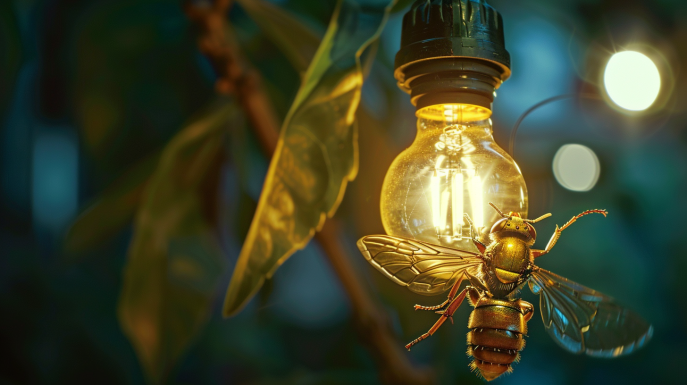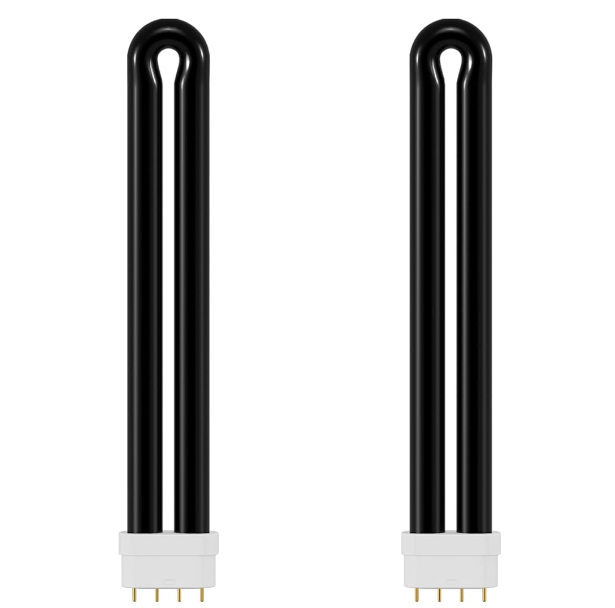
24W B24B Black Light Replacement Bulb
- FIT MODELS: Compatible with Stinger Model BK300, BK310, BK500, BK510 bug zapper. Product Size: 10.2″ H x 1.8″ L x 0.9″ W.
- EFFECTIVE: 2G11 T6 24W black light bulb attracts mosquitoes, gnats, moths, and other flying insects without chemicals.

24W Bug Zapper Replacement Light Bulb
- Each power: 24W Quantity: 1pc Length: 249mm / 9.8 in N.W.: 0.5kg or less Effective area: 20㎡-50㎡ Packing List ● 1 PCS 24W Ultraviolet Bulbs
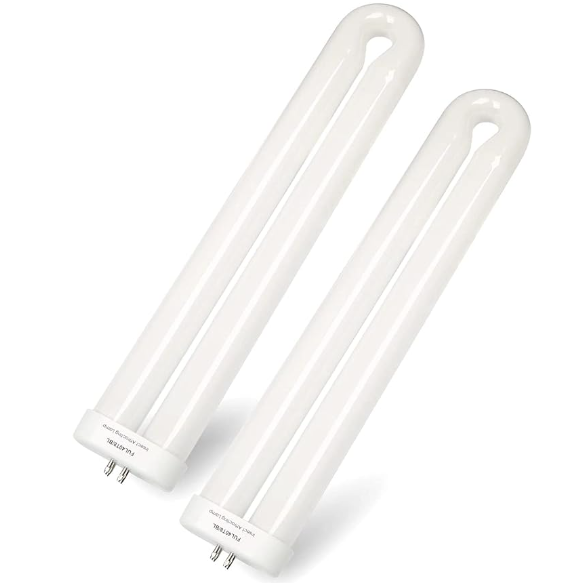
Bug Zapper Replacement Light Bulb
- Spec: Mosquito attracting bulb, Size 12.3*2.3*1.14 inch, UVA 365nm Blue light,U-shapped tube
- Compatible: BK-80D, FC7600, GL-2400, FC-2600, FC-4400, FC4410, FC-4800, FC-4810,
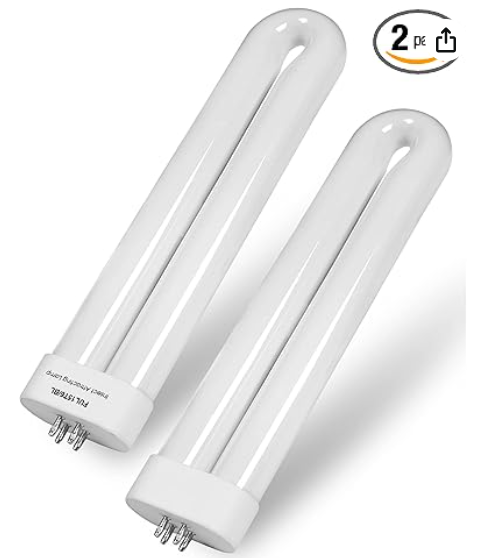
7.5 Inch Bug Zapper Replacement Bulb
- IMPORTANT!!!! – Please measure and confirm the bulb size before order (bulb size: 7.5×1.6×0.95 inch)
- Widely use- Compatible for Black Flag, Stinger 15W bug zapper, e.g. UV15, FP15, TZ15, BK-15C; BK-15D; BK-2000; GL-1450; GL-2020; GL-2050; GL-3515; PM-1500; PM-2000; PM-2015B, BZ-15, BZ-20.
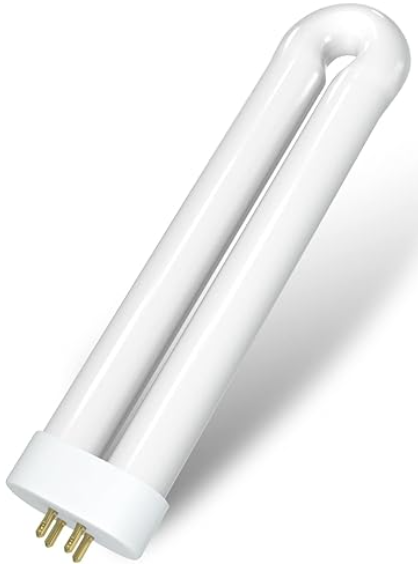
Bug Zapper Light Bulb Replacement for 15W Bug Zapper with 4-Pin Base
- FIT MODELS: Compatible with T6, T8, and T9 bug zapper, please measure and confirm the bulb size of the original bug zapper before purchasing.
- EFFECTIVE: This 15W UV lamp which emit 365nm wavelength blue light, attracts mosquitoes, gnats, moths, and other flying insects to the device.
Illuminating Your Outdoor Space While Keeping Insects at Bay
Picture this: a warm summer evening, the aroma of grilled food wafting through the air, and the sound of laughter as friends and family gather on your patio. It’s the perfect scene, except for one tiny problem – those annoying buzzing insects threatening to crash your party. Enter the Stinger Bug Zapper, your silent guardian against these uninvited guests. But like any superhero, it needs its power source to keep fighting the good fight. That’s where the Stinger Bug Zapper bulb comes in, and today, we’re going to dive deep into everything you need to know about these bug-banishing beacons.
The Heart of the Zapper: What Makes It Tick?
Let’s start with the basics. The Stinger Bug Zapper uses a special type of ultraviolet (UV) bulb designed to attract insects like moths to a flame – quite literally. These aren’t your average household bulbs; they’re specifically engineered to emit a wavelength of light that’s irresistible to flying pests. Think of it as a siren song for bugs, luring them to their demise.
But here’s the kicker – not all UV bulbs are created equal. Stinger has fine-tuned their bulbs to emit just the right frequency to maximize bug attraction while minimizing unnecessary power consumption. It’s like they’ve cracked the code of the insect world, and we’re all benefiting from it.
The Replacement Dance: When and Where?
Now, you might be wondering, “How often do I need to replace this magical bug-luring bulb?” Great question! The lifespan of a Stinger Bug Zapper bulb typically ranges from 3,000 to 5,000 hours of use. For the average user, that translates to about one to two seasons of bug-zapping goodness. But let’s be real – if you’re living in a bug-heavy area or you’re the neighborhood’s go-to spot for outdoor gatherings, you might find yourself replacing it more frequently.
When the time comes for a bulb swap, you’ve got options. Many hardware stores carry replacement bulbs, but for the best selection and guaranteed compatibility, heading to the Stinger website or authorized retailers is your safest bet. Amazon and other online marketplaces also stock these bulbs, often at competitive prices. Just be sure you’re getting the genuine article – knockoffs might save you a few bucks upfront, but they could cost you in effectiveness and longevity.
The Price of Peace (and a Bug-Free Zone)
Speaking of cost, let’s talk numbers. A replacement Stinger Bug Zapper bulb typically runs between $15 to $30, depending on the specific model and where you purchase it. Yes, it’s a bit more than your average light bulb, but remember – this isn’t just any bulb. It’s your frontline defense against a barrage of biting, buzzing invaders. When you break it down by the number of peaceful, bug-free evenings it provides, it’s a small price to pay for tranquility.
Pro tip: Keep an eye out for seasonal sales or bulk discounts. Stocking up during the off-season can save you some cash and ensure you’re always ready for impromptu outdoor festivities.
The Reviews Are In: What’s the Buzz?
Before you commit to a purchase, it’s always wise to see what others are saying. A quick scan of customer reviews reveals a generally positive consensus on Stinger Bug Zapper bulbs. Users rave about their effectiveness, with many noting a significant reduction in flying pests around their outdoor spaces. Some even go as far as to call these bulbs “life-changing” for their ability to reclaim their yards from mosquito tyranny.
However, it’s not all glowing praise. A few users mention issues with bulb longevity, particularly in humid environments. Others note that while the bulbs are effective against most flying insects, they seem less attractive to mosquitoes specifically. It’s a good reminder that while these bulbs are a powerful tool in your bug-fighting arsenal, they’re not a silver bullet for all pest problems.
Installation: Easier Than You Think
Got your new bulb and ready to install? Good news – it’s a breeze! Here’s a quick step-by-step:
- Ensure your zapper is unplugged and cool to the touch.
- Open the zapper according to the manufacturer’s instructions.
- Carefully remove the old bulb – it might be a good idea to wear gloves, just in case.
- Insert the new bulb, making sure it’s securely in place.
- Close up the zapper, plug it in, and voilà! You’re back in the bug-zapping business.
Remember, safety first! Always follow the manufacturer’s guidelines and handle the bulb with care to avoid breakage.
Energy Efficiency: Zapping Bugs, Not Your Wallet
In an age where we’re all trying to be more eco-conscious, you might be wondering about the energy efficiency of these bulbs. The good news is that Stinger has put some serious thought into this. While UV bulbs generally consume more energy than standard LED bulbs, Stinger has optimized their design to be as efficient as possible while still maintaining peak bug-attracting performance.
Most Stinger Bug Zapper bulbs range from 7 to 40 watts, depending on the model. To put that in perspective, it’s roughly equivalent to leaving a couple of energy-efficient light bulbs on. When you consider the alternative – multiple cans of bug spray or less effective solutions – the energy usage seems pretty reasonable.
One Size Doesn’t Fit All: Choosing the Right Bulb
Here’s where things get a bit tricky. Not all Stinger Bug Zappers use the same bulb. The wattage and size can vary depending on the model of your zapper. Before you make a purchase, double-check your zapper’s specifications or consult the user manual. Using the wrong bulb not only risks ineffective performance but could potentially damage your unit.
Stinger offers bulbs in various wattages, typically ranging from 7W to 40W. Higher wattage bulbs generally cover a larger area but consume more energy. Consider the size of your outdoor space and your typical bug population when choosing. For a small patio, a lower wattage might suffice, while larger yards or areas with heavy insect activity might benefit from a more powerful bulb.
The Green Guide: Proper Disposal of Used Bulbs
Let’s talk eco-responsibility for a moment. UV bulbs, including those used in Stinger Bug Zappers, contain small amounts of mercury. This means they can’t just be tossed in the trash when they burn out. Many hardware stores and recycling centers offer free recycling for these types of bulbs. Some even have mail-in programs if you don’t have a local option. It’s a small extra step that makes a big difference for our environment.
UV vs. LED: The Great Debate
You might have noticed LED bug zappers hitting the market and wondered if they’re a better option. While LED technology has made impressive strides, when it comes to attracting bugs, UV still reigns supreme. The specific wavelength emitted by UV bulbs is simply more attractive to a wider range of flying insects. That said, LED technology is evolving rapidly, so it’s worth keeping an eye on developments in this area.
Brand Loyalty: Stick with Stinger or Branch Out?
Here’s a common question: “Can I use Stinger bulbs in other bug zapper brands, or vice versa?” While it might be tempting to mix and match, especially if you find a good deal, it’s generally best to stick with the brand-specific bulbs. Stinger has designed their bulbs to work optimally with their zappers, ensuring the best performance and safety. Using off-brand bulbs might void your warranty and could potentially be a safety hazard.
Troubleshooting: When Zapping Goes Wrong
Even the best bug zappers can have off days. If you find your Stinger isn’t performing as well as it used to, the bulb is often the culprit. Here are some signs it might be time for a replacement:
- Dimming light output
- Flickering or inconsistent operation
- Visible darkening at the ends of the bulb
- A significant decrease in the number of bugs being attracted
If you’ve replaced the bulb and are still having issues, it might be time to check other components like the electrical grid or transformer. Remember, when in doubt, consult a professional or contact Stinger’s customer support.
Safety First: Handling with Care
Replacing a bug zapper bulb isn’t rocket science, but it does require some caution. Always unplug the unit and allow it to cool completely before attempting any maintenance. Wear gloves to protect your hands from both the potential for broken glass and any residual charge in the unit. And if you’re not comfortable with the process, there’s no shame in seeking help from a more DIY-savvy friend or professional.
The Bottom Line: Is It Worth It?
After diving deep into the world of Stinger Bug Zapper bulbs, the verdict is clear: for those seeking a reliable, effective way to keep flying pests at bay, these bulbs are a solid investment. While they may require a bit more attention and cost than your average light bulb, the payoff in terms of outdoor comfort is substantial.
Remember, the key to getting the most out of your Stinger Bug Zapper is regular maintenance and timely bulb replacement. By staying on top of this simple task, you’re ensuring that your outdoor space remains a welcoming oasis for friends and family – and a no-fly zone for pesky insects.
So, as you gear up for your next backyard barbecue or quiet evening on the patio, take a moment to check your bug zapper. Is the bulb still shining bright, ready to keep your gatherings bug-free? If not, you now have all the knowledge you need to make an informed purchase and keep the good times rolling, insect-free.
Here’s to many more peaceful, buzz-free summer nights ahead. Happy zapping!

